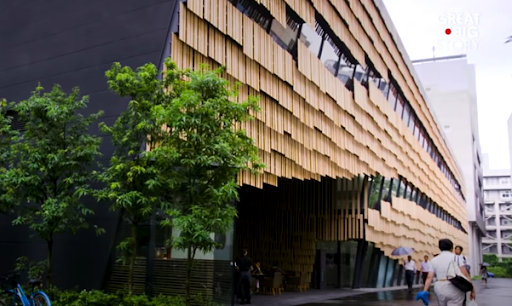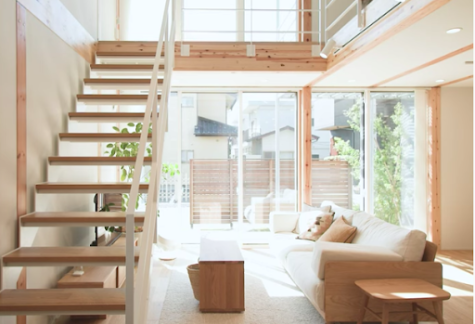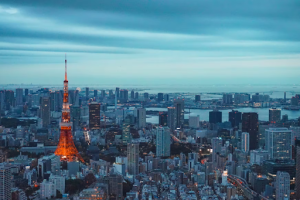
Kengo Kuma’s architecture Daiwa Ubiquitous Computing Research Building. (Photo credit: Great Big Story, YouTube)
Sustainable architecture in Tokyo
Buildings account for around 40% of annual global CO2 emissions, according to the non-profit organization, Architecture2030. The Japanese Cabinet’s goal is to have zero-energy for newly built houses by 2030. This goal means that the Japanese government is aiming for newly built houses to consume less energy than their production of renewable energy.
Japanese architecture has long been associated with having a clean and minimal look, and taking influence from natural surroundings. Traditional Japanese homes include tatami, a mat made of rice straws that cover the floor, paper shoji screens, and wooden bamboo structures. However, as Japanese homes continue to modernize, the question arises on how eco-friendly the future of Japanese homes will be.
One way architecture has evolved to decrease the building’s ecological footprint is through a construction concept called a “passive house”. A passive house concentrates on how natural sources such as sunlight, shade, wind interact with the house, instead of relying solely on a heating or cooling system. One company which practices this concept of a “passive house” using solar energy, is MUJI. MUJI’s “wood house” is designed with spacious windows which allow sunlight to fill throughout the room. This would reduce the amount of energy used in lighting and heating, showing how houses can be both cost-efficient and environmentally friendly.

(Photo credit: Muji House, YouTube)
A leading pioneer in contemporary sustainable architecture is Kengo Kuma, who has won the Global Award for Sustainable Architecture in 2016. In an interview by Great Big Story, Kuma describes how he uses local materials, mainly wood and bamboo found in the local area for his architecture projects. According to Kuma, one of the advantages of using wood as a construction material is how easily it can be replaced and repaired once it becomes damaged, while with concrete, the whole building may at times have to be replaced. Kuma also raises awareness of the relationship between the environment and human well-being through his architecture, and stresses the importance of staying in harmony with the surrounding nature.

In an interview by CNN featuring Kuma on “How buildings can create harmony”, he says his main goal is to “merge the building into the environment as much as I can.” By learning to live within nature instead of clearing habitats such as forests to build homes, humans will be able to reconnect and become more conscious about their impact on their surrounding environment.

(Photo credit: Unsplash)
However, as the human population increases, there is going to be a higher demand for more apartment buildings. By 2050, it is projected that the proportion of the world’s population desire to live in urban areas will increase to 68%, according to the UN department of economic and social affairs, which may pose a problem for the 2030 zero-energy target for newly built houses in Japan. Tokyo alone offers to sell many vacant lands to build houses or apartment buildings which will create immense impacts on our environment if not properly managed. For instance, the question of where the leftover materials from destruction of old houses and buildings will go to, the management of those wastes, and the noise and air pollution given off by construction sites will be crucial to address.
The cost to build an environmentally friendly house is also high. What people are looking for, such as solar panel residential rooftop installations, for example, may not be within an individual’s personal budget. The durability of solar panels is said to degrade after 20+ years which may lead to the necessity of a replacement, causing an additional price for construction of buildings and houses.
The Japanese government’s net zero goal for new buildings may seem ambitious, yet with the encouragement and support from the government, public policy makers, architects, and the public, environmentally friendly practices in architecture will become the new future in Japan.
